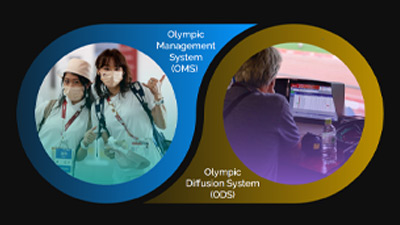Locked-in before lockdowns
At a glance
The speed and agility required to execute the Olympic and Paralympic Games during COVID didn’t appear overnight. The IOC and Atos have been leading their jointly-managed technology organization to this point for 30 years.
Outcomes
- Olympic system tests were virtual for the first time in history.
- Ten-times more remote users of Commentator Information System.
- Flawless delivery to the largest remote audience in history.

True team effort
The Olympic and Paralympic Games are operationally enormous and complex. The Tokyo 2020 edition, for example, was the coordinated effort of 500.000 people including athletes, Olympic and Paralympic officials, journalists and support staff from 206 nations. More than 878 competition events needed to be managed according to each sport’s distinct rules. Those events were timed, broadcast, analyzed and distributed live. And every two years, when the Olympic and Paralympic Games move to a different city, the whole infrastructure must be set up in the new location with different laws, languages and ways of working.
How do they do it?
From athlete accreditation and program management to live results distribution and analysis, modern Olympic Games couldn’t happen without technology. Since 1989, the International Olympic Committee (IOC) has entrusted its key technology operations to Atos, one of the world’s leading digital services providers.
Atos is lead integrator, responsible for orchestrating and securing all the IT systems that run the Olympic Games. The digital organization behind the Tokyo 2020 edition comprised teams from Atos, the IOC, Tokyo 2020 Organizing Committee and other partners working together in three broad streams:

Integration
The lead integrator ensures that systems function together properly to meet user and security requirements. “We have been responsible for the overall IT program management for many editions of the Olympic and Paralympic Games. This means that even if we’re not delivering every single IT piece, we design the infrastructure and integrate, coordinate and secure all the pieces,” said Àngels Martín, General Manager of the Olympic Games for Atos.

Applications
Atos manages the critical apps (more than 150 for Tokyo 2020 ranging from accreditations to web widgets) that support the smooth running of the Olympic and Paralympic Games. See the apps of Tokyo 2020 infographic for an overview of the landscape. “We took a bold new approach to modernizing the infrastructure and applications for Tokyo 2020: adopting DevSecOps and agile workflows along with microservices-based architectures for many of the critical applications,” said Martín.

Cloud Orchestration
“Our partnership with Atos goes back to the days of mainframe computing when the only option was to manage computer systems on-site in the host city – at extra cost and complexity for organizing committees. Today, these systems are fully orchestrated and managed in the cloud,” said Frederic Wojciechowski, Head of Systems and Service Integration, IOC.
Applications and other digital functions are now managed remotely in a model built once for repeated use. It features one technology operations center (TOC) in the host city closely connected to a Central TOC in Barcelona, Spain, and an Integration Testing Lab (ITL) in Madrid, Spain; and a worldwide network of security operations centers (SOCs).
No downtime
It takes five years to prepare the technology for each edition of the Olympic Games. Delivering them every two years, as this digital organization does, requires actively working on various phases of at least two editions in parallel at all times. This story follows a single project timeline for Tokyo 2020, which began in 2016.
2016
Plan

In the first year, the Organizing Committees worked with Atos to develop the master plan, identify stakeholders and define responsibilities.
2017
Design

Over the next year, they defined business requirements for every system, digital service and physical venue, and finalized the overall system infrastructure.
2018
Build

“Two years before Games time, we build. When we say ‘build,’ it’s more than building the systems. The most important part is building out our teams, having the right skills on each position, ramping the team up in line with the master plan and gaining an understanding of them all,” said Nacho Moros, Chief Operations Officer, Atos Major Events.
2019
Test

The newly formed teams spent the next year testing integration and systems. They simulated individual events in the ITL and then simulated the full Olympic workloads with end users.
2020
Operate

Normally, digital teams spend the first half of the year on venue deployment, disaster recovery and technology rehearsals followed by six weeks of Olympic and Paralympic Games time.
The year of the Olympic Games began on schedule — until March 24, 2020, when they were postponed for one year due to the global COVID-19 pandemic. How did a team at this scale adapt to a yearlong pause followed by delivery during pandemic lockdowns, travel restrictions and social distancing rules?
Hard reboot
That Tuesday in March, the digital teams froze their systems and revisited meticulous plans to deliver on the new schedule and under very different circumstances. Rather than ending in 5 months, the Tokyo 2020 project would restart during operations for the next two Olympic Games: Beijing 2022 and Paris 2024.
“We had to adapt the teams and systems because of the way the events would be delivered,” said Martín. First, they learned there would be no spectators. Later, it was announced that other attendees — the federations, delegations, journalists, broadcasters and support staff who normally attended — would be reduced to a minimum.
To help every participant meet this requirement, Atos summoned its spirit of innovation. “We were implementing on the fly for the first time to enable remote execution of many tasks that had only ever been done physically on-site,” said Nacho Moros, COO Olympic Games and Major Events at Atos. This is how they managed remote homologation and hybrid physical-virtual testing. And it’s how they ran development and testing in parallel with Beijing 2022 while starting Paris 2024. More simply, it’s how most of the digital organization could work remotely.
Then, closer to Games time, requests for remote media access spiked. Atos quickly reconfigured its systems to handle 10 times more broadcasters and commentators, allowing them to provide full coverage more safely from their home countries.
Even essential personnel who remained in Tokyo were required to work remotely from each other. In rapid response, Atos reconfigured the layout of the IT premises. Teams were divided into bubbles that could not mix. The bubbles added an element of choreography to daily tasks. A venue bubble, for example, could not be in contact with a TOC bubble.
2020 foresight
Innovative spirit aside, the technological magic behind this rapid pivot to remote control was the cloud migration that began with London 2012. Critical systems were integrated and hosted in the cloud by 2018. And the applications were modernized to cloud-native, 100% cloud-hosted and fully orchestrated on Atos’s sustainable hybrid cloud delivery model by 2020.
Along with the migration, the apps were split into microservices. Half of them were containerized for Tokyo (with 90% targeted for Beijing) to leverage full cloud efficiencies. The Olympic Games had an agile DevSecOps model in place at Tokyo with 50% lower costs, 10% fewer defects and 20% higher productivity through automated deployment and agile adoption.
“One of the main benefits of the DevSecOps model is a clear efficiency improvement from previous Olympic and Paralympic Games. In Tokyo, we could do any modification, go through the full automation test cycle and deploy that suite in hours,” said Moros.
The new model has also reduced the Olympic Games’ carbon consumption by minimizing travel, physical servers, square meters of space and heat emanation. As an added benefit, centralizing delivery in Spain helped many technology partners who could not travel outside the EU for testing or technology rehearsals but could go to Spain.
It was those types of efficiencies, plus many weekends on the job, that allowed staff to work triple duty on all three editions instead of the usual double duty. They had the technology locked-in well before COVID lockdowns. Without a hitch, when Games time arrived, digital operations were ready to do what they do best: remain invisible while the Olympians do what they do best: inspire.
They inspired the largest remote audience in history — traffic on Olympic digital platforms was 50% higher compared to Rio 2016. And everyone remained as safe as possible.
Tokyo 2020 accomplishments*
An asterisk (*) on a sports record commonly indicates something unusual about the accomplishment. In the history of the Olympic Games, Tokyo 2020 will forever be marked by many asterisks of COVID. Here are a few digital asterisks that won’t make it into the sports almanacs.

In 2020, digital operations swiftly adapted to a new project schedule for three editions in parallel: Tokyo 2020, Beijing 2022 and Paris 2024.

It was the first time that system tests and technology rehearsals were completed virtually in the history of the Olympic Games.

Atos issued 535,000 accreditations, beating previous records despite travel restrictions.

After Tokyo 2020, operations had only six months to move to China for the Olympic Winter Games Beijing 2022.
The final asterisk comes from the countless organizations and people who make these events possible. Their security vigilance protected not only systems but also health and safety in this unusual time:

Between July and September 2021, Atos managed 815 security events per second (a total of 4.4 billion) for Tokyo 2020, and none of them affected the Olympic Games.
Related resources
Client story
Accelerating app delivery at Tokyo 2020
App delivery at Tokyo 2020 with Atos and delivery partner Micro Focus.

Infographic
The apps of Tokyo 2020
Olympic & Paralympic Games depend on more than 150 critical apps for management and diffusion.
Behind the scenes
Meet our Tokyo 2020 heroes – Episode 4
Matthieu Androdias and Christophe Thivet on striving for excellence.


